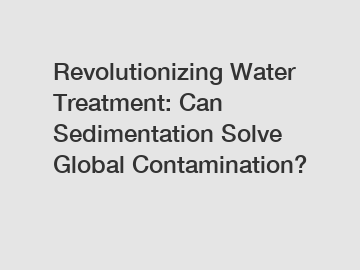Revolutionizing Water Treatment: Can Sedimentation Solve Global Contamination?
Freshwater scarcity and contamination have become significant global challenges, affecting the well-being of communities and ecosystems worldwide. As we search for innovative solutions, sedimentation emerges as a promising technique that holds the potential to revolutionize water treatment. In this blog, we will explore how sedimentation can address global water contamination, providing an effective and sustainable means of purifying our most precious resource.
Understanding Sedimentation:
Sedimentation, a process that involves the removal of suspended particles from water, has been used for centuries. The principle is simple yet effective: allowing particles to settle under the influence of gravity, resulting in clearer, safer water. As we advance technologically, we can leverage sedimentation methods to develop efficient and scalable solutions to combat water pollution on a global scale.

The Impact of Global Water Contamination:
Water contamination presents dire consequences for human health and the environment. With an estimated 2.2 billion people lacking access to safe drinking water, unsafe water sources and inadequate sanitation cause millions of deaths annually. Similarly, aquatic ecosystems suffer from pollution-related degradation, threatening biodiversity and ecosystem services. To address these pressing challenges, we must look beyond traditional water treatment methods.
Revolutionizing Water Treatment:
1. Enhanced Sedimentation Systems:
New technologies in sedimentation enable us to maximize its effectiveness. By employing innovative sedimentation basins and intelligent monitoring systems, we can achieve higher removal rates and minimize the chances of recontamination. Incorporating lamella plates or inclined tubes for increased surface area enhances particle settling, ultimately improving water quality.
2. Sedimentation in Combination with Advanced Techniques:
Pairing sedimentation with other water treatment methods amplifies its impact. Techniques like coagulation, flocculation, and filtration can be sequentially applied to further enhance the removal efficiency of suspended particles, pathogens, and chemical pollutants. Additionally, combining sedimentation with advanced oxidation processes can address complex organic contaminants and emerging pollutants effectively.
3. Portable Water Treatment:
Sedimentation can play a pivotal role in the development of portable water treatment solutions. Communities in remote areas or emergency situations often lack access to clean water sources. Deploying cost-effective and compact sedimentation units can provide portable treatment systems that eliminate sediment, pathogens, and other contaminants. This would greatly improve the quality of water available and enhance the health and well-being of those in need.
Advantages of Sedimentation:
- Cost-effectiveness: Sedimentation is relatively affordable and requires minimal energy input compared to more complex treatment processes.
- Simple operation and maintenance: The operation and maintenance of sedimentation units are straightforward, making this technique accessible even in resource-limited settings.
- Sustainable: Sedimentation does not require the addition of chemicals, reducing the generation of hazardous waste and minimizing the ecological footprint.
Challenges and Future Directions:
While sedimentation is a highly effective solution for water treatment, challenges remain. It may not effectively remove pollutants such as dissolved organic compounds, heavy metals, or certain pathogens. Continuing research and development are vital to refine sedimentation methods and overcome these limitations.
Furthermore, sedimentation should be integrated into holistic water management approaches that focus on source protection, water reuse, and comprehensive monitoring systems. Implementing decentralized treatment systems tailored to specific contexts will enhance overall water quality and contribute to long-term sustainability.
Conclusion:
As global water contamination becomes an ever-urgent issue, sedimentation emerges as a front-runner in revolutionizing water treatment. Its simplicity, efficacy, and environmental sustainability make it an attractive solution for producing safe, potable water. By incorporating new technologies, combining methodologies, and fostering portable systems, we can address the world's growing water crisis while upholding the principles of human health and ecological preservation. Together, let's embrace sedimentation and create a future where access to clean water is a universal reality.
For more information, please visit cooling tower nozzle design, frp water tanks, aquarium foam filter.
189
0
0

Comments
All Comments (0)